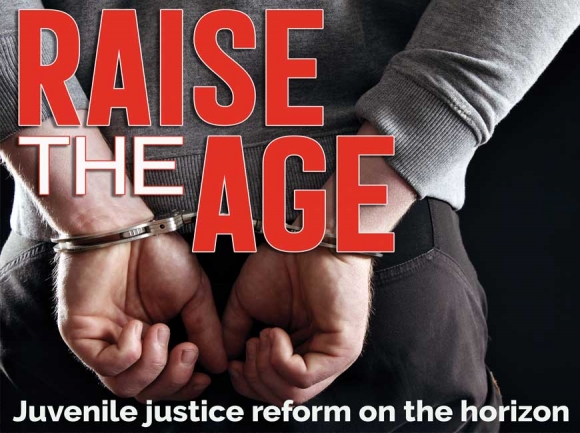The cost of compassion: Influx of juvenile cases could cause cash crunch

A juvenile justice system already stressed to the limit is about to be stretched even further, thanks to a change in state law that will increase caseloads as well as the need for youth diversionary programs. And although this coming change has been on the radar for some time now, there’s still no clear signs on who’s going to pay for it, how or when.
It’s called the Juvenile Justice Reinvestment Act, passed by the North Carolina General Assembly with broad bipartisan support in 2017.
What it does is increase the age of juvenile jurisdiction — except for certain felonies — by changing the definition of “delinquent juvenile” from someone younger than 16 years of age to someone younger than 18 years of age.
Beginning Dec. 1, 2019, those who are aged 16 or 17 years old when they commit crimes will now be handled though the juvenile, rather than the adult justice system.
“Ultimately the goal is to make them productive members of our society, so they’re not stuck in this court system, because it’s hard. Once you get tagged with a charge, especially a felony when you’re young, that really sort of determines the rest of your life,” said District Attorney Ashley Welch. “And 16 and 17 year-olds do really stupid stuff. They’re being teenagers. So we need to change the way that we think and try to keep them out of our adult system as long as we can. For what I would call your teenage stupidity stuff, you don’t need to be sitting in adult district court.”
Taken into context with the long history of juvenile justice, few would think that’s a bad idea. In the 1700s, children who committed crimes were still treated a lot like adults, and were usually incarcerated together with them. In the 1800s, apprenticeships and industrial workhouses attempted to “save” juvenile delinquents, but there was still little differentiation between them and older offenders.
Related Items

During the 1900s, an early attempt at serious reform in North Carolina resulted in the 1907 creation of the Stonewall Jackson Manual Training and Industrial School, near Concord. Funded by state legislature in 1909, the school was considered progressive at the time because it only served youth offenders.
It still was far from perfect; overcrowding, violence and vasectomies authorized by the state eugenics board still took place.
Not long after Stonewall opened, reformers pushed for the first N.C. Juvenile Court Act, passed in 1919 with the aim of treating rather than punishing juveniles. Among other things, it led to the employment of juvenile probation officers, the practice of probation for youth offenders, a juvenile court system and, importantly, the separation of youth offenders from adults.
Throughout the rest of the 20th century, little changed until the 1970s, when community-based alternatives to Stonewall-style schools came into fashion. In 2000, the General Assembly created what was then a cabinet-level Department of Juvenile Justice and Delinquency Prevention, which is now under the jurisdiction of the N.C. Department of Public Safety.
This latest move to “raise the age” — as it’s being called — is the newest trend in the evolution of juvenile justice; with its 2019 adoption, North Carolina will become the 50th state to do so.
“There’s a whole lot of research out there that the brain of a child doesn’t completely develop, some of the ones I’ve seen is like even until the mid-20s,” Welch said. “Some people mature quicker and some a whole lot later. They’ll do just sort of stupid teenage stuff that could rise to the level of a crime, and the way that our system is now, they’ll end up in adult court, and that’s not always the best thing.”
Welch said that her office has tried to be creative in the past, focusing on deferred prosecutions and diversionary systems to help young people get on the right track, something prosecutors across the state have also done; statistics from the N.C. Department of Public safety back up that claim and show a marked decrease in juvenile detention center admissions since 2000. [see chart]
The “raise the age” legislation makes this approach much more formal.
“There’s a whole lot more attention placed on them than if they were in the adult system,” Welch said. “[Before ‘raise the age’] if they came through our system and they were 16 years old, got charged with possession of drug paraphernalia and got convicted, they’re going to get a fine and costs, and they’re not going to get supervision and it’s going to stay on their record — it’ll follow them around. With this program they’re going to get services, treatments, drug assessments, hopefully mental health if they need that, and it doesn’t show up on their record so they’re not being set up to fail later in life.”
The exclusion of 16 and 17-year-olds from the adult court system — and, consequently, the county detention centers — should have a positive impact on jail populations.
Swain County Sheriff Curtis Cochran said that since Jan. 1, 2017, his department has housed seven 16-year-olds and seven 17-year-olds who wouldn’t have been there at all had the law been passed sooner. Haywood Sheriff Greg Christopher has said that it costs taxpayers about $78 a day to keep someone — of any age — in the Haywood Detention Center.
The law could also prevent some of those 16 and 17-year olds from appearing in adult courts later in life, as long as the diversionary measures put in place work well.
“In the long run, what you’re going to see is we’ll be able to deter repeat juvenile offenders so by the time they become adults, they won’t end up in the adult system,” Welch said. “So at the end of the day, if we’ve been able to help and successfully treat a juvenile before they turn 18, we may never see them in the adult system.”
It’s not all positive, however; increased caseloads on the juvenile side — and the expenses associated with that — will require additional funding.

“I think a lot of people have been worried about it,” said Welch. “There will be some growing pains. It’s certainly going to increase caseloads on the juvenile side. The average disposition time for a juvenile case — because you have to do a plea transcript and it’s a whole lot more formal — it takes a whole lot longer to deal with, just in the courtroom.”
That left Welch leery of the proposal, which she still thinks is a good thing, if it’s paid in full.
“Initially when they were first discussing this, I was not a supporter of it in general, because of the funding,” she said. “I even went to Raleigh and spoke to the [Juvenile Justice] committee and said, ‘Look, if you’re going to do this, you’ve got to provide us with some money and resources in order to do it correctly.’ That’s always been my concern.”
Marcus Metcalf shares that concern. As the executive director of something called the HIGHTS (Helping Inspire Gifts of Hope, Trust and Service) program, he’s been on the front lines of juvenile delinquency for more than a decade.
“When she first started doing programs with us she was in fifth grade,” Metcalf said of a student he’d worked with in the program. “Her mom was addicted to drugs, her dad was dead after being in prison. She had extensive, extensive trauma, exposure to pretty horrible stuff. So not just us but a team of people … we just kind of stayed in this kid’s life through the years, whether her mom would go back to jail or some other crazy traumatic thing would happen. Last year, we saw her graduate. She walked across the stage. To us that was success, that she wasn’t addicted to drugs, she wasn’t pregnant, wasn’t in prison, she had a steady job for a long time.”
A lot of juvenile offenders are referred to programs like Metcalf’s, which serves about 150 kids a year in Hawyood, Jackson, Macon and Swain counties on an annual budget of around $300,000.
“We are total mom-and-pop,” he said. “We are mainly volunteer-run, partnership-run, we partner with Western Carolina University and public schools for a lot of support, just putting the pieces together, because the funding is so poor for these services.”
HIGHTS supports at-risk or vulnerable youth, and works directly with juvenile justice, social service and mental health professionals to identify and help the most vulnerable students in the community through adventure-based programs, free summer camp programs and afterschool programs.
“That’s really where we started,” he said. “And then we’ve grown into all sorts of weird spots in the community, from buying shoes to emergency school safety services.”
Like Welch, Metcalf has been well aware of the forthcoming change that could lead to substantial increases in his caseload.
“Every county that we work in has been preparing for the last year or two, just kind of looking down the road, trying to estimate what that number’s going to be,” he said. “Every community’s going to have a different amount. Some of the more rural counties won’t be as deeply affected, but some of the ones with higher populations, Buncombe, Haywood, could have a pretty significant increase.”
Also like Welch, Metcalf wonders where the money’s going to come from, and when.
“That’s a great question. The reality is, we’re not exactly sure,” said Metcalf. “The Juvenile Crime Prevention Council takes this small chunk of money, the county puts in a matching piece, and then those people decide how locally they want to spend that money to best serve the population, whether that’s restitution or mediation or the HIGHTS program. We’re already paying for these people in the adult system. They just need to make sure that money is transferred into a juvenile continuum.”
Metcalf said that there’s been a promise by state legislators that JCPC budgets will be increased, which should equate to more funding for programs like his.
“That’s been the promise,” he said. “Whether they follow through with that, there’s no guarantees in that. None of the money has been fully secured.”
The need for such diversionary programs isn’t decreasing, and “raise the age” will certainly ensure that remains the case for the foreseeable future. Regardless of funding, Metcalf said that HIGHTS will do its best to serve at-risk youth like that girl he saw wearing a cap and gown instead of an orange jumpsuit and handcuffs.
“We are dedicated to meeting the need. We live in this community. Whether our funding sources go up or down, we are going to remain dedicated to filling that service for the community,” he said. “If our budget increases because we have to serve more kids, then we’re going to go around hat-in-hand to more churches and people and try to raise the money to support it, because we understand that if we’re don’t provide these services to these students now, then we’re going to pay for them exponentially throughout their lives through incarceration and addiction.”









